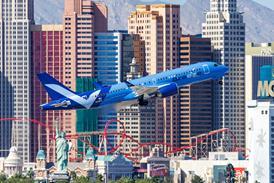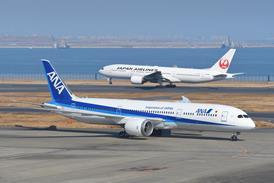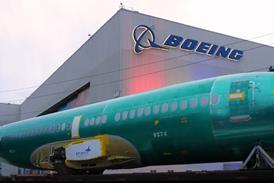Scope clause relaxation and innovative JetBlue have enabled Embraer to break into the US market earlier than expected with its larger jets of up to 110 seats
A little under two years ago, Embraer decided to change the name of its new family of jet aircraft to reflect the more mainstream role it envisaged. For its larger models the company dropped the ERJ prefix associated with the regional jet, so that the ERJ-170 and ERJ-190 became the Embraer 170 and 190. Frederico Fleury Curado, Embraer's executive vice-president for civil aircraft, says of the aircraft: "This is a new concept. It really is a mainliner."
It was a prescient move, since Embraer's two biggest orders until now for the 170 and 190 are from mainline US carriers: US Airways has ordered 85 of the 70-seat Embraer 170, with options for 50 more; while low-cost carrier JetBlue Airways has become the launch customer for the 100-seat Embraer 190 with firm orders for 100 jets and options for a further 100 aircraft.
Of the 244 firm orders overall for the 170/190 family, all but two are from mainline carriers or leasing giant General Electric's GECAS.
Mauricio Botelho, Embraer's president and chief executive, says the orders vindicate Embraer's belief when it launched the programme that it could fill what it calls the "seat capacity gap" in the market.
"Both orders were very much an endorsement of the view we had - that the niche from 70 to 110 seats was not occupied only as a consequence of an artificial market restriction," he says, referring to the scope clauses in US mainline pilot agreements. These clauses have for years restricted what type and how many aircraft could be flown by regional affiliates of the majors.
Botelho adds that an airline must view a route not just as a geographic issue but also as "an economic equation", with a certain number of people wanting to be transported at a certain price. "You must solve that equation with the proper solution - an aircraft of an appropriate size to make a profit for the airline," he says. "If you use a bigger aircraft than the economic equation demands, you won't fill your aircraft. If you use a smaller aircraft, you will leave passengers on the ground for the competition, and lose the market. This vision was the driving factor for the launch of the Embraer 170 and Embraer 190 family - right-sizing the aircraft to the market."
Weight gains
Although there are Airbus and Boeing products in the 100- to 110-seat range, Botelho says they cannot compete with the new Embraers. "They are close in capacity, but they are not close in economics," he claims. That is because they were designed to match another equation, he explains, noting, for instance, that the Airbus A318 is a shrink of the A320. He adds that Bombardier's CRJ900 is also a stretch of a smaller regional jet.
The argument certainly resonated with JetBlue, which spent nine months analysing available aircraft to operate in smaller and medium markets to supplement its Airbus A320 operations. The carrier looked at the A318, Boeing 717-200 and Bombardier CRJ900. "The conclusions on the 717 and A318 were that they were simply too large," says John Owen, JetBlue's executive vice-president and chief financial officer. The CRJ900 was rejected because it could not offer the kind of passenger comfort level JetBlue seeks, he adds.
Because Embraer started design of the aircraft with a clean sheet, it was able to create the right-sized fuselage cross-section, Owen says, noting that with two-by-two seating at a 32 in (813mm) pitch, the 190 offers wider seats and a slightly wider aisle than the A320. "It was absolutely the kind of comfort level we thought essential to continue the JetBlue experience," he says.
As with its A320s, the airline will equip the 190s with leather seats and DirecTV satellite programming screens for each passenger.
Embraer has also been emphasising the spacious overhead bin and under-seat stowage of the 170/190 family, and the fact that its two forward and two aft doors will facilitate the quick turn times so valued by JetBlue.
The Brazilian manufacturer had input from 30 airlines in the design stage, and says the substantially lower weight of the 190, compared with the Airbus and Boeing models, is of key importance. The 10t weight difference will translate into substantial savings on direct operating costs, such as fuel burn and weight-related navigation and landing fees.
Flexibility gains
The 190's flexibility also means the aircraft can operate efficiently on shorter-distance routes or out to its 3,900km (2,100nm) range, Owen says: "This is not a regional jet. It's a small jet designed for mid-sized markets."
On fairly conservative assumptions, such as utilisation of 11h a day - compared with the 13h a day logged by the A320s - JetBlue built a schedule for the 190 from the ground up, market by market. The results showed a unit cost differential of about 1¢ more per seat mile (0.6¢/km) on a comparable stage length, Owen says, adding that the aircraft generated forecast margins at least as good, if not better, than those JetBlue is getting on the A320.
On a 5-600km stage length, the unit cost differential may be about $3 more a seat, says David Neeleman, JetBlue's chief executive, but he adds that it will have a lot more cities to choose from.
He says that in the markets they were looking at, both from its home base at New York Kennedy and other cities, JetBlue would expect fares to drop 50-60% with a new 190 service. If it goes into a market where the average fare is $200, it does not really matter whether the airline comes in with a $60 or $64 fare, he says, arguing that its entry will still stimulate the market. "We're very comfortable with the ability to charge a few more bucks."
In any case, Neeleman says the 190's lower trip costs will allow JetBlue to break-even with 60-61 seats filled on a 100-seat 190, compared with 119-120 passengers on the 162-seat A320.
Contradicting the argument that "commonality" benefits favour the A318, Neeleman says the smallest Airbus aircraft would have largely the same trip costs as the A320, including the same cockpit and crew pay. "It didn't make any sense," he says, adding that its A320s have International Aero Engine V2500s, a powerplant not available on the A318.
As for the flightdeck crew pay differential, JetBlue will be paying proportionally less for 190 pilots than for their A320 equivalents. New pilots - and JetBlue has 6,000 applications on file - can bid to start in the 190 or the A320; they will make less money initially by choosing the 190, but will end up making more because the income for a 190 captain will be higher than for an A320 first officer, Neeleman says.
JetBlue will have almost 80 A320s in its fleet when the 190s arrive. The airline is scheduled to take delivery of seven 190s in the fourth quarter of 2005 and about 18 190s a year through 2011, when its options begin.
Neeleman says there are hundreds of potential markets for the 190. Besides new destinations in the north-east USA and Midwest, he mentions the possibility of using the 190 to open new routes to Canada, the Caribbean or Mexico. The aircraft will give JetBlue the ability to add frequencies to supplement its A320s, to spread costs through the stations by connecting already served dots, and to build new markets. "I think the possibilities are endless," he says.
Neeleman also dismisses the idea that the addition of a second fleet type is a risky diversion from its business plan: "This is not a departure from our business plan; it's an augmentation. We think we will have less risk going forward if we can spread our network wider to additional markets."
US Airways reliance
For its part, US Airways has made increased reliance on small jets a critical component of its plan to return to profitability. Once it emerged from bankruptcy protection, one of the carrier's first orders of business was to place orders for the Embraer jets, as well as for 60 50-seat Bombardier CRJ200s and 25 75-seat CRJ700s.
US Airways president and chief executive David Siegel says the new jets can replace larger aircraft on routes with poor or marginal mainline performance and complement them on other services at key times. The dual-class 170, which will be operated exclusively by its Mid-Atlantic Airways division rather than its regional carriers, may also be used at times of lower demand to replace the A319 on hourly shuttles between New York, Boston and Washington.
A key factor in the US Airways Embraer order was "the family concept of the 170/190 line of aircraft", Siegel says. "This order for the Embraer 170 is the starting point."
The reasoning behind the orders is almost as gratifying to Botelho as the new business itself, and he is especially gratified that JetBlue rejected the "commonality" argument.
"Everyone, in their prayers, asks God for a monopoly," he says. "But fortunately for us consumers, God doesn't listen to them." Then he adds, laughing: "I don't say that I don't make my own prayers."
REPORT BY CAROLE SHIFRIN IN SAO JOSE DOS CAMPOS, BRAZIL
Source: Airline Business























